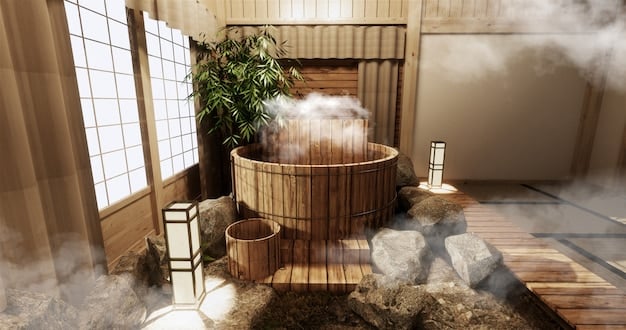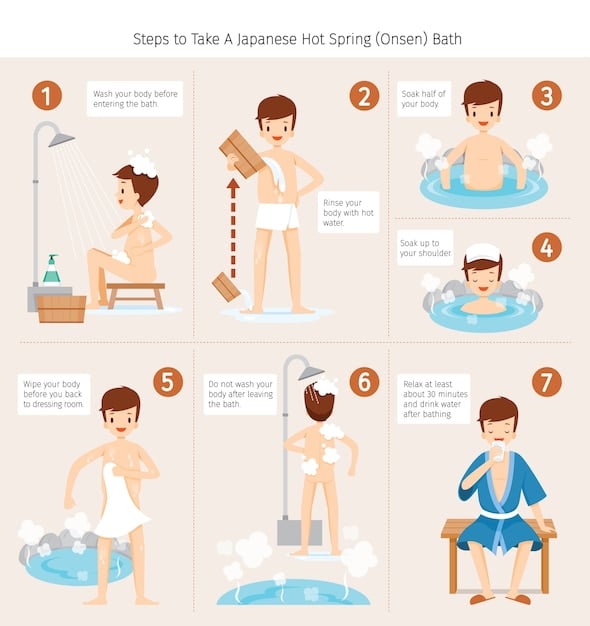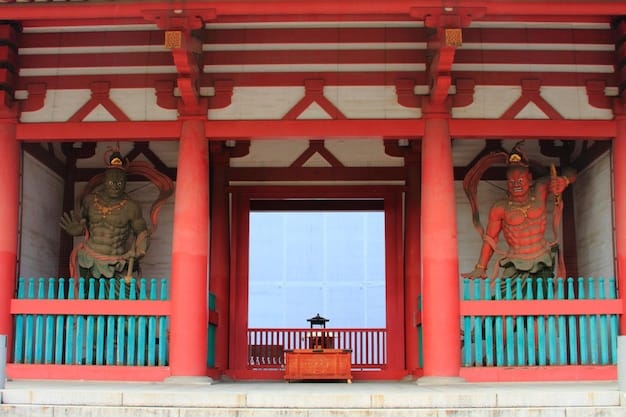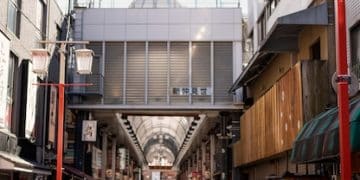Navigating Japanese Bathhouses (Sento): A 2025 Guide for US Visitors

Navigating Japanese public bathhouses, known as sento, requires understanding specific customs and etiquette to ensure a respectful and enjoyable experience; this 2025 guide provides US visitors with essential information on sento etiquette, what to bring, and how to fully immerse themselves in this unique aspect of Japanese culture.
Visiting a Japanese public bathhouse, or sento, is a cultural experience unlike any other. As you plan your trip for 2025, understanding the nuances of sento etiquette will enhance your immersion into Japanese culture and ensure a relaxing and respectful visit.
What is a Sento? Understanding Japanese Public Bathhouses
Sento are more than just places to get clean; they are community hubs steeped in tradition. Understanding their history and cultural significance is crucial before your visit.
Sento, or public bathhouses, have been a part of Japanese culture for centuries, evolving from Buddhist temples to community fixtures where people gather to relax and socialize. Unlike onsen, which use natural hot spring water, sento use heated tap water.
The History of Sento
The origins of sento can be traced back to Buddhist temples, where bathing was a ritualistic practice. Over time, these bathing facilities became more accessible to the general public. During periods when many homes lacked private baths, sento served as essential community hubs.
Sento vs. Onsen
It’s important to differentiate between sento and onsen. Onsen utilize naturally heated geothermal spring water and are often located in resort towns. Sento, on the other hand, use heated tap water and are typically found in urban areas.
- Water Source: Sento use heated tap water; onsen use natural hot spring water.
- Location: Sento are typically in cities, onsen in resort areas.
- Experience: Both offer a relaxing experience but onsen often have more natural settings.
Understanding these differences will help you choose the right bathing experience during your trip to Japan.
In summary, sento provide a unique cultural experience rooted in Japanese history and community, offering a convenient and relaxing way to unwind. They differ from onsen primarily in their water source and location.
Essential Sento Etiquette for US Visitors
To ensure a respectful and enjoyable experience at a sento, understanding and adhering to proper etiquette is key. These guidelines will help you navigate the cultural norms.
Entering a sento requires understanding specific customs to avoid unintentional offense. From undressing to washing, each step has its own set of rules.

Undressing and Preparing for the Bath
Upon entering the sento, you’ll find separate changing rooms for men and women. Here’s what you need to know:
- Undress Completely: Bathing in a sento requires complete nudity. Leave your clothes in the provided lockers or baskets.
- Bring a Small Towel: Carry a small towel (tenugui) to use for washing and drying. It can also be used for modesty while moving around.
- Footwear: Remove your shoes before entering the changing room and place them in the designated area.
The Washing Ritual
Before entering the communal bath, it’s essential to thoroughly wash your body. This is a crucial part of sento etiquette.
- Washing Stations: Sit on a stool at a washing station equipped with faucets, soap, and shampoo.
- Clean Thoroughly: Use the provided soap and shampoo to wash your entire body thoroughly. Rinse off completely, ensuring no soap residue remains.
- Respect Others: Be mindful of splashing water on other bathers. Keep the area clean for the next person.
In the Bath
Once you are clean, you can finally enter the bath. It’s important to continue being respectful of the space and other bathers.
- Enter Slowly: Ease yourself into the hot water gradually.
- No Towels in the Water: Do not put your towel in the bathwater. You can place it on your head or to the side of the bath.
- Be Quiet: Maintain a quiet and respectful demeanor. Sento are meant to be relaxing spaces.
By following these etiquette guidelines, you’ll ensure a pleasant and culturally respectful visit to a sento.
In conclusion, proper sento etiquette involves undressing and preparing correctly, performing a thorough washing ritual, and behaving respectfully in the bath. Adhering to these customs will enhance your experience and show respect for Japanese culture.
What to Bring to a Sento: A Packing List
Knowing what to bring to a sento will ensure you are prepared and comfortable. Here’s a simple packing list to guide you.
Preparing for your sento visit involves gathering a few essential items. Having these items on hand will make your experience smoother and more enjoyable.
Essential Items
These are the must-have items for your sento visit:
- Small Towel (Tenugui): A small cotton towel is essential for washing and drying.
- Shampoo and Soap: While some sento provide these, it’s best to bring your own travel-sized toiletries to ensure you have what you need.
- Change of Clothes: Bring clean clothes to change into after your bath.
Optional Items
These items are not essential, but they can enhance your comfort and convenience:
- Conditioner: If you use conditioner, bring your own, as it’s not always provided.
- Hair Tie: If you have long hair, a hair tie will help keep it out of your face and the water.
- Plastic Bag: A small plastic bag is useful for carrying wet items home.
Items Provided by the Sento
Most sento provide certain amenities, but it’s good to know what to expect:
- Lockers: Lockers are available in the changing room to store your clothes and belongings.
- Stools and Basins: Washing stations are equipped with stools and basins for your use.
- Hot Water: Of course, the main attraction! You can expect varying temperatures, so be careful!.
In short, bringing a small towel, your own toiletries, and a change of clothes will cover the essentials. Optional items like conditioner and a plastic bag can add to your comfort. Most sento provide lockers, stools, and basins.
In summary, packing the right items will make your sento visit more enjoyable and convenient. A small towel, toiletries, and a change of clothes are essential, while other items can be added for extra comfort.
Navigating the Sento Experience: Step-by-Step
Understanding the practical steps of the sento experience will help you feel more confident and at ease. Here’s a step-by-step guide.
The sento experience can be broken down into several key steps. Knowing what to expect at each stage will help you navigate the process smoothly.

Entering and Paying
The first step is entering the sento and paying the entrance fee:
- Find the Entrance: Look for the distinctive noren (a fabric divider) at the entrance, often blue for men and red for women.
- Pay the Fee: Pay the entrance fee at the reception desk, typically around 400-500 yen.
Changing and Storing Your Clothes
Next, you’ll proceed to the changing room to prepare for your bath:
- Separate Changing Rooms: Enter the appropriate changing room (男 for men, 女 for women).
- Undress and Store: Undress completely and store your clothes in a locker or basket.
- Take Your Towel: Take your small towel and any toiletries you brought with you.
Washing and Rinsing
Thoroughly cleaning yourself before entering the bath is crucial:
- Choose a Washing Station: Sit on a stool at a washing station.
- Wash Thoroughly: Use soap and shampoo to wash your body and hair. Rinse completely.
Enjoying the Bath
Finally, you can relax and enjoy the hot bath:
- Enter the Bath: Carefully step into the hot bath.
- Relax and Soak: Soak in the hot water and enjoy the peaceful atmosphere.
- Exit Slowly: When you’re ready to leave, exit the bath slowly and dry yourself off with your small towel.
These steps will guide you through the sento experience, ensuring you know what to expect at each stage. From paying the fee to enjoying the bath, each step is designed to provide a relaxing and culturally enriching experience.
In conclusion, navigating the sento experience involves entering and paying, changing and storing your clothes, washing thoroughly, and enjoying the bath. Following these steps will help you feel comfortable and confident during your visit.
Health Benefits of Visiting a Sento
Beyond cultural immersion, visiting a sento offers various health benefits. The heat and communal atmosphere can contribute to overall well-being.
Sento are not only cultural experiences but also offer several health benefits. The heat and communal atmosphere can contribute positively to your overall well-being.
Physical Benefits
The heat of the bath can provide several physical benefits:
- Muscle Relaxation: The hot water helps to relax tense muscles and relieve soreness.
- Improved Circulation: Heat promotes better blood circulation, which can aid in recovery and reduce inflammation.
- Skin Health: The steam and warm water can open pores and cleanse the skin.
Mental Benefits
The relaxing atmosphere of a sento can also have mental health benefits:
- Stress Reduction: Soaking in hot water can reduce stress and promote relaxation.
- Improved Sleep: A warm bath before bed can improve sleep quality.
- Community Connection: Sento are communal spaces that can foster a sense of community and reduce feelings of loneliness.
Precautions
While sento offer numerous health benefits, it’s important to take certain precautions:
- Stay Hydrated: Drink plenty of water before and after your bath to prevent dehydration.
- Avoid Alcohol: Do not consume alcohol before entering a sento, as it can increase the risk of dizziness and fainting.
- Limit Time: Limit your soaking time to 15-20 minutes to avoid overheating.
In summary, visiting a sento can provide physical benefits such as muscle relaxation and improved circulation, as well as mental benefits like stress reduction and improved sleep. Taking precautions like staying hydrated and limiting soaking time will help you enjoy the experience safely.
In conclusion, sento offer numerous health benefits, including physical relaxation, improved circulation, and mental well-being. By taking necessary precautions, you can safely enjoy these benefits during your sento visit.
Finding Sento: Resources and Tips for US Visitors
Locating a sento in Japan can be easier with the right resources and tips. Here’s how to find a sento and make the most of your visit.
Finding a sento during your travels in Japan can be a rewarding experience. There are several resources and tips you can use to locate and enjoy these public bathhouses.
Online Resources
These online resources can help you find sento near you:
- Japan-Guide.com: This website offers information on sento and onsen, including locations and etiquette tips.
- Time Out Tokyo: This site provides listings of recommended sento in Tokyo.
- Google Maps: Search for “銭湯” (sento) in Google Maps to find nearby bathhouses.
Tips for Finding Sento
Here are some practical tips for locating sento:
- Look for Signs: Sento are often marked with a sign displaying “湯” (yu), which means hot water.
- Ask Locals: Locals can be a great resource for finding hidden gems and less touristy sento.
- Check with Your Accommodation: Your hotel or guesthouse may have recommendations or even offer sento passes.
Making the Most of Your Visit
To enhance your sento experience, consider these tips:
- Go During Off-Peak Hours: Visit during weekday mornings or afternoons to avoid crowds.
- Bring Cash: Most sento only accept cash.
- Respect the Rules: Follow the etiquette guidelines to ensure a pleasant experience for everyone.
In short, online resources like Japan-Guide.com and Google Maps can help you find sento. Looking for signs, asking locals, and checking with your accommodation are useful tips. Enhancing your visit involves going during off-peak hours, bringing cash, and respecting the rules.
In conclusion, finding sento is made easier with online resources, local insights, and practical tips. By utilizing these resources and respecting sento etiquette, you can enjoy a truly authentic Japanese cultural experience.
| Key Point | Brief Description |
|---|---|
| 🧼 Sento Etiquette | Proper undressing, thorough washing, and respectful behavior in the bath. |
| 🎒 What to Bring | Small towel, toiletries, and a change of clothes are essential items. |
| ♨️ Health Benefits | Muscle relaxation, improved circulation, and stress reduction. |
| 📍 Finding Sento | Use online resources or ask locals for recommendations. |
Frequently Asked Questions
▼
Many sento still prohibit tattoos due to their association with organized crime. However, some are becoming more accepting. It’s best to inquire beforehand or choose a sento that specifically allows tattoos. You can also cover them with a bandage or waterproof tape.
▼
Yes, it’s recommended to bring your own small towel (tenugui) for washing and drying. Some sento may rent or sell towels, but it’s more convenient and hygienic to have your own. This small towel is a sento essential.
▼
Yes, sento always have separate bathing areas for men and women. The entrances are typically marked with 男 (otoko) for men and 女 (onna) for women. Be sure to enter the correct changing room and bathing area, or you may find yourself in an awkward situation.
▼
The entrance fee for a sento is typically around 400-500 yen (approximately $3-4 USD). This is a fixed price and usually paid at the reception desk upon entering. The affordable price makes sento accessible to many.
▼
No, swimsuits are generally not allowed in sento. Bathing is traditionally done in complete nudity. The point is to wash and relax together without any barriers. So you have to be bare to enter and enjoy these bathhouses.
Conclusion
Navigating Japanese public bathhouses in 2025 will be an even richer experience with knowledge of sento etiquette, what to bring, and the health benefits they offer. By respecting these customs and being prepared, US visitors can fully enjoy this unique aspect of Japanese culture, fostering a deeper appreciation for the traditions and community spirit that sento embody.





